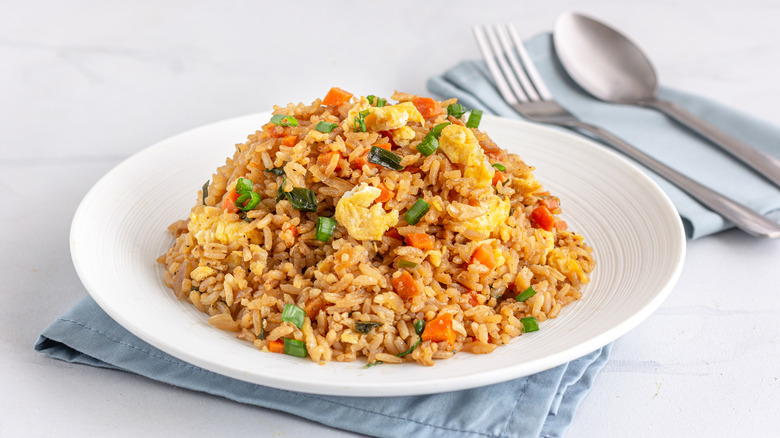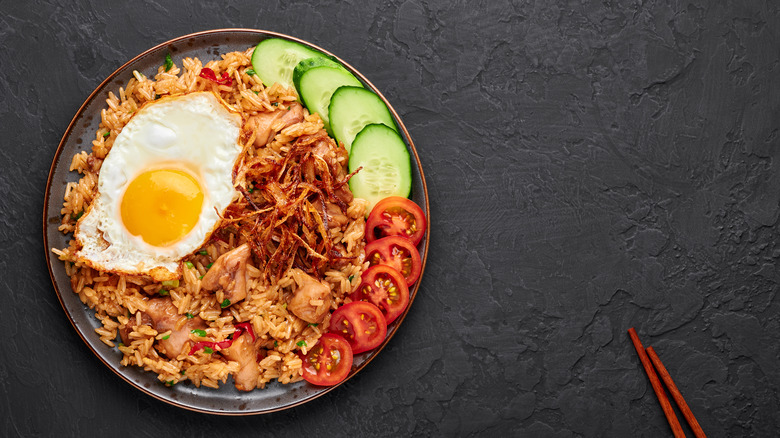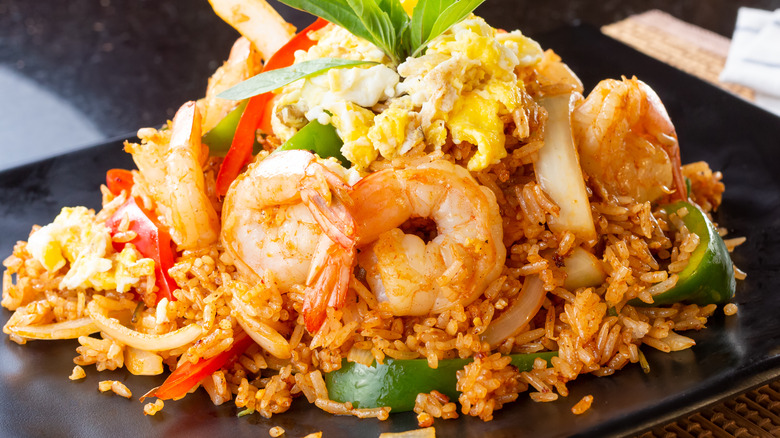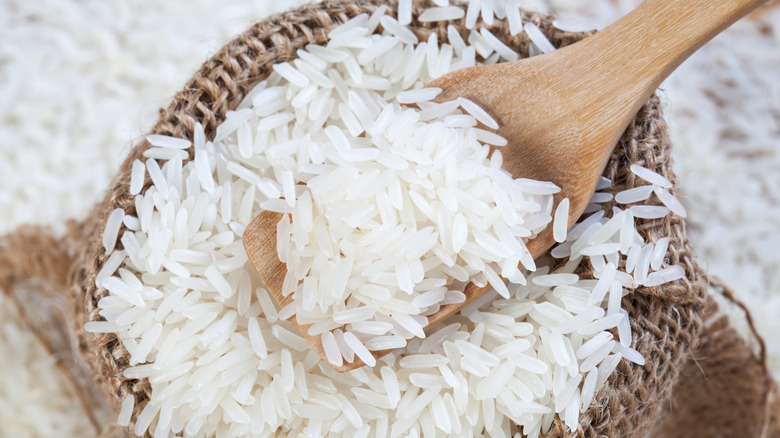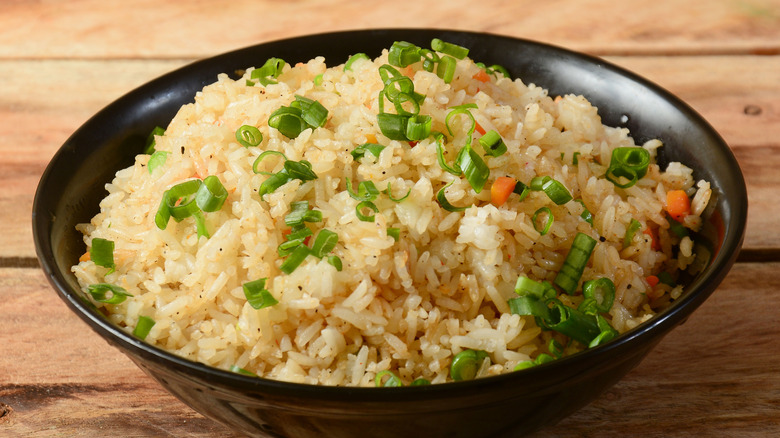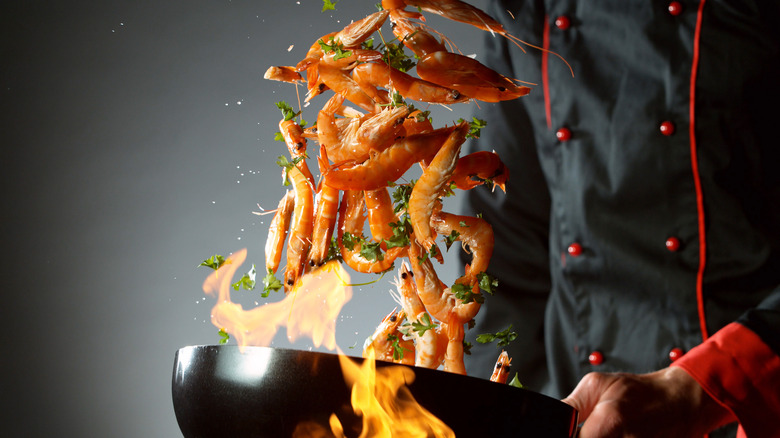The Untold Truth Of Fried Rice
Fried rice is a classic Chinese dish that often appears on restaurant menus. This delightful, delicious jumble of rice and mix-ins also boasts a long, illustrious history that cannot be ignored. Fried rice was originally invented in China, and today, it is a delicious dish in its own right.
Over the years, fried rice has evolved to suit local palates all over the world. Various renditions of fried rice that draw from cultures and cuisines of countries such as Thailand, Japan, and even the U.S. have originated as well. Fried rice is deceptively simple and almost impossibly quick to throw together, as evident by this 30-minute fried rice recipe. While it can be easy to prepare, fried rice can turn out quite soggy if precautions aren't taken to reduce moisture prior to cooking.
From its rich history to its contemporary evolution, from time-tested tips and tricks to mastery and modern flair, there's so much to know about this incredible dish.
Fried rice was invented as a way of using up leftovers
Today, fried rice is often consumed as a meal in its own right. However, Eating China reports that fried rice was originally invented as a way of using up leftover rice. In China, where fresh, fluffy, white rice is preferred, fried rice is a matter of convenience and economical meal planning. It was a way for low-income families to consume rice and vegetables that may be past their prime and to save money in the process.
There is no better way to use up small amounts of meat, vegetables, and leftover rice: Simply fry them all together in a wok, add soy sauce, and you've got fried rice! These days, creative recipes even call for adding other items to fried rice. Ingredients such as herbs, nuts, seeds, or even cheese are all unexpected foods to add to fried rice that make this Chinese dish even tastier.
Fried rice was likely invented in China during the sixth century
The origins of fried rice can be hazy, but according to ifood.tv, most historians agree that they date back to the Sui dynasty. The dish was most likely created in Yangzhou City sometime between A.D. 589-618.
The fact that fried rice arose in the Southern parts of China is perhaps no surprise since residents of southern China are traditionally particularly avid consumers of rice. Fried rice is as intrinsic to Southern Chinese cuisine as dishes such as panzanella or ribollita are to Italy. Therefore, it makes sense that locals in South China came up with innovative ways to use and consume fried rice.
According to The Daily China, the stir-frying technique used to make fried rice only grew in popularity in the late Ming dynasty (A.D. 1368-1644); however, today, this technique is popular throughout China, and indeed, around the world!
Multiple variations of fried rice exist around the world
Fried rice may have originated in China, but these days, various versions of this dish exist all over the world. According to Three Guys from Miami, Cuba, once home to the largest Chinatown in Latin America, has a version called arroz frito (literally fried rice in Spanish) that uses leftover lechón asado as the main protein source. Meanwhile, in Macau, arroz chau chau is a popular rendition of fried rice that is made with ham, as per YouTuber Receitas com sabor.
According to Just One Cookbook, in Japan, yakimeshi is made with short-grain rice in place of the long-grain rice used in traditional Chinese iterations of the dish. Yahimeshi is often stir-fried with ham, egg, and green onion; in Osaka, this dish may be seasoned with Worcestershire sauce instead of soy sauce. Indonesia is famous for its dark, caramelized nasi goreng that is seasoned with sweet kecap manis sauce and topped with a runny fried egg.
American fried rice is a popular dish in Thailand
Thailand is yet another country home to its own iterations of fried rice, including khao pad goong, or fried rice with shrimp. According to Eating Thai Food, this dish is typically served with a wedge of lime and prik nam pla (chile-scented fish sauce) on the side. But this is not the only kind of fried rice that is well known in Thailand!
Indeed, According to Marion's Kitchen, Thailand boasts an American fried rice recipe that entails stir-frying rice with onions, sausages, ham, peas, and raisins and seasoning it with a sweet-and-savory sauce made with fish sauce, soy sauce, and ketchup. American fried rice can be served with fried chicken strips and a fried egg. This dish is incredibly beloved in Thailand and is eaten in cafes as well as at home. American fried rice is especially popular among kids, although this comforting version of fried rice can be enjoyed by everyone.
Fried rice came to America in the 19th century
Fried rice's popularity in the U.S. can largely be attributed to the influx of Chinese immigrants during and following the Gold Rush in the 19th century. During this time, Chinese workers in America were generally employed in low-income sectors such as agriculture, factory work, mining, and railroad construction. According to Simmer, some people in these immigrant communities would often prepare the comfort food dishes that reminded them of home. Fried rice was just one economical meal that people in Chinese communities cooked and ate.
According to TIME, Chinese restaurants proliferated at this time, grew to be quite popular, and offered incredibly delicious food. They served dishes that we now associate with American Chinese cuisine, such as chop suey, which translates to "odds & ends." Indeed, chop suey is yet another dish made from leftovers that has conquered the hearts and palates of Americans!
Leftover rice will give you the best results
There is one key secret to the success of fried rice: According to The Takeout, leftover rice is actually the best base for cooking up this tasty dish, much more so than fresh rice. Indeed, fluffy, steamy rice just won't do if you're looking for the perfect fried rice texture. It all comes down to keeping the moisture out of the dish. According to Food52, cold rice that has been refrigerated overnight is the best since it's less likely to go mushy when you're stir-frying it.
Additionally, The Spruce Eats adds that the dryness of old rice further contributes to the ideal texture in the final fried rice dish. Using freshly steamed rice will render the final fried rice mushy and soft, far from the typically desired texture of fried rice. Day-old rice can be used, although rice that was cooked two to three days ago is ideal.
If you don't have leftover rice, you can tweak fresh rice
Just because you don't have any cooked rice hanging around in the fridge doesn't mean you can't make fried rice if you've got a hankering for it. According to The Takeout, if you don't have old rice, you can cook up some rice the morning of the day you plan to serve fried rice for dinner and spread it out on a baking sheet to dry before cooking it into fried rice.
Of course, this technique still requires a bit of forethought, effort, and time. If you want to go from cooked to fried rice even more quickly, The Spruce Eats cites a tip from chef Ming Tsai who recommends making rice, spreading it out on a baking sheet, and freezing it for about half an hour. While the texture might not be quite as good as if you used day-old rice, it's certainly a good quick fix.
Fried rice is best made with jasmine rice
Since rice is the focal point of fried rice, the kind of rice used is paramount to the recipe's success. According to Food52, most fried rice recipes begin with medium- or long-grain jasmine rice, although a few exceptions, such as the Japanese iteration of fried rice, rely on short-grain rice. The longer grains of jasmine rice are sturdier and thus hold up better when fried.
Jasmine rice is native to Southeast Asia; according to The Kitchn, it gets its fragrance from the presence of a compound called 2-Acetyl-1-pyrroline, which is also found in white bread and pandan. The compound bestows a popcorn-like aroma to the rice, which tends to taste buttery. That being said, since fried rice is all about invention and leftovers, any rice will do. You can even stir-fry brown rice for a delicious dish that has a bit of nuttiness to it.
Less is more when it comes to soy sauce and add-ins
It can be tempting to overload your fried rice with extra ingredients and seasonings, but as the name of the dish suggests, the rice should really be the focal point of any fried rice recipe. When it comes to fried rice, less is more. According to The Takeout, the soy sauce should be added in minimal quantities that are just enough to give a tawny color to the rice. In China, small packets of vegetables are sold specifically for the purpose of being mixed into fried rice.
The Spruce Eats echoes this minimalistic mentality, noting that even seasonings should be minimal or completely absent. A touch of salt is all that is needed: The flavor of the individually stir-fried ingredients (and, of course, the rice) should shine. So choose your mix-ins wisely and season with restraint; the finished dish will be all the tastier for it.
Cooking fried rice requires a wok's high-heat temperatures
The pan that is used to cook fried rice is just as important as the rice and the ingredients that are being used. According to The Woks of Life, a wok is essential for success as it reheats quickly after the addition of new ingredients, especially over high heat, which is non-negotiable for making fried rice.
The use of a wok and the specific technique of wok tossing has actually been scientifically proven to make the perfect batch of fried rice. A study in the Journal of the Royal Society found that wok tossing allowed for super high heat (we're talking 1200 ºC) to be applied to food without burning it.
The study even defined an optimal process for wok tossing and making fried rice. This process is oriented towards improving techniques and reducing the likelihood of sustained injuries for professional chefs who are working with woks on a regular basis.
Eggs are key to a good fried rice recipe
Unsurprisingly, fried rice is sometimes known as egg fried rice: Many will agree that eggs are almost as important as the rice in terms of the quality of the final dish. The Spruce Eats notes that eggs can either be fried separately and used as a garnish or else scrambled and mixed right into the rice. The Takeout, meanwhile, calls for scrambling the egg in medium-hot oil and carefully folding the resulting egg pillows into the rice for the ideal texture.
China Today notes that the golden fried rice of the Sui Dynasty was evenly coated in eggs and recommends doing the same in modern-day recipes of fried rice, along with the addition of key ingredients such as ham, chicken, mushroom, scallop, sea cucumber, and bamboo shoot. The result is a beautiful fried rice dish with eggy goodness in each and every bite.


